Beginners Guides
How Big Can A Tiny House To Not Have To Get A Permit
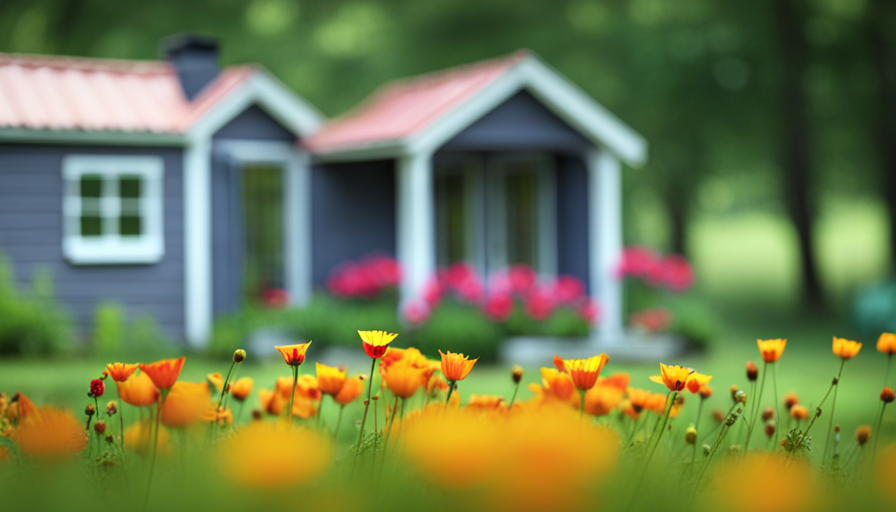
What is the maximum size a tiny house can reach before requiring a permit?
This is a question that many aspiring tiny house owners find themselves asking. As someone who has gone through the process of building and living in a tiny house, I understand the importance of navigating through local regulations and building codes.
In order to avoid the hassle of obtaining a permit, there are several factors to consider. First and foremost, it is crucial to familiarize yourself with the zoning regulations in your area. Additionally, understanding the building codes is essential to ensure your tiny house meets safety requirements.
The foundation type, utility connections, and the purpose of your tiny house are all aspects that will impact whether or not a permit is necessary. Lastly, staying up to date with local laws is crucial as regulations may change over time.
By following these guidelines, you can confidently build a tiny house that meets the size requirements to avoid the need for a permit.
Key Takeaways
- Factors such as foundation type, utility connections, and purpose of the tiny house impact the need for a permit.
- Familiarize yourself with local zoning regulations to determine if a permit is needed.
- Understanding building codes is crucial for meeting safety requirements.
- Stay up to date with local laws as regulations regarding tiny houses may change over time.
Understand Local Zoning Regulations
Don’t let pesky permits get in the way of your dream tiny house – find out exactly what your local zoning regulations allow!
Understanding local zoning restrictions and building permit requirements is crucial when determining how big your tiny house can be without needing a permit. Each town or city has its own set of rules and regulations regarding the size and placement of structures, so it’s important to research and comply with these guidelines.
Local zoning regulations typically dictate the maximum square footage, height, setbacks, and even the type of foundation allowed for tiny houses. By familiarizing yourself with these regulations, you can ensure that your tiny house meets all the necessary requirements.
Now, let’s move on to the next section and discuss how to familiarize yourself with building codes.
Familiarize Yourself with Building Codes
When it comes to building a tiny house, it’s important to familiarize yourself with the building codes.
One key point to consider is the minimum size requirements set by the local building department. These requirements may vary depending on the location, so it’s crucial to research and understand the specific regulations in your area.
Additionally, it’s essential to consider safety and health regulations to ensure that your tiny house meets the necessary standards for occupancy and living conditions.
Learn About Minimum Size Requirements
To avoid obtaining a permit, you can build a tiny house that meets the minimum size requirements set by your local zoning regulations. These requirements vary from one jurisdiction to another, so it’s crucial to familiarize yourself with the specific rules in your area. Here are four key points to consider when it comes to minimum size requirements:
-
Research: Begin by researching the minimum square footage required for a dwelling in your locality. This information can typically be found in your local building codes or zoning ordinances.
-
Consult: If you’re unsure about the requirements or need clarification, don’t hesitate to reach out to your local building department or zoning office for assistance.
-
Flexibility: Some areas may have flexibility in their minimum size requirements, allowing for alternative options such as utilizing loft spaces or multi-functional furniture to maximize the use of limited square footage.
-
Exceptions: Certain jurisdictions may have exceptions or exemptions for tiny houses on wheels or accessory dwelling units (ADUs), so be sure to explore these possibilities.
Considering safety and health regulations is crucial when building a tiny house, as they ensure the well-being of its occupants and comply with legal requirements.
Consider Safety and Health Regulations
Adhering to safety and health regulations is crucial in ensuring the well-being of occupants and maintaining legal compliance in the construction of a compact dwelling. When designing a tiny house, it is important to consider safety precautions and health regulations to create a safe and healthy living environment.
To ensure safety, it is necessary to take measures such as installing smoke detectors, fire extinguishers, and carbon monoxide detectors. Additionally, proper ventilation and insulation are essential to prevent mold growth and maintain good air quality.
In terms of health regulations, it is important to follow guidelines for waste management, including proper disposal of sewage and waste water. Furthermore, ensuring access to clean water and a reliable electrical system is crucial for the well-being of the occupants.
By adhering to these safety precautions and health regulations, you can create a safe and healthy living space within the confines of a tiny house. Consider the foundation type for your compact dwelling to ensure stability and structural integrity.
Consider the Foundation Type
First and foremost, let’s explore the different foundation types for a tiny house and how they can affect the need for a permit. When considering foundation options for your tiny house, it’s essential to keep in mind the building restrictions imposed by local authorities.
Here are three common foundation types and their implications:
-
Permanent foundation: Constructing your tiny house on a permanent foundation, such as a concrete slab or crawl space, may exempt you from certain permit requirements. However, it’s crucial to ensure compliance with local building codes.
-
Pier foundation: Utilizing pier foundations, consisting of concrete piers or steel posts, can offer flexibility and portability. Depending on your location, this type of foundation may allow you to avoid obtaining a permit for your tiny house.
-
Skid foundation: Using skids, which are large beams or timbers, to support your tiny house allows for mobility. This type of foundation typically does not require a permit, as the structure is not permanently fixed to the ground.
Considering the foundation type is just one aspect of determining whether a permit is required. To ensure compliance with all regulations, it’s essential to consult with a professional in your local jurisdiction.
Consult with a Professional
It’s crucial to seek guidance from a local professional to ensure compliance with all regulations when determining whether a permit is necessary for your tiny house project. Consulting with a professional offers numerous benefits, such as receiving expert advice on local zoning laws and building codes. They can help you navigate the complex permit process and ensure your tiny house meets all necessary requirements. By consulting with a professional, you can avoid costly mistakes and potential legal issues down the line. They can provide valuable insights on foundation types, materials, and construction techniques that will help you stay within the permitted size limits. Additionally, they can assist in obtaining any required permits or variances. By seeking professional guidance, you can move forward with your tiny house project confidently and with peace of mind. As you consider utility connections, it’s important to be aware of the necessary steps.
Be Aware of Utility Connections
When planning your project, consider how utility connections will fit into the overall design and layout of your tiny home. This is an important aspect to consider because utility connections are essential for a comfortable and functional living space. Here are some key points to keep in mind when dealing with utility connections in your tiny house:
-
Research local zoning regulations: Before proceeding with any utility connections, it’s crucial to understand the specific regulations in your area. Different locations may have different requirements and restrictions regarding utility connections in tiny houses.
-
Plan for water and sewage connections: Ensure that you have access to a reliable water source and a proper sewage system. Depending on your location, you may need to connect to a public water supply or consider alternative options such as rainwater harvesting or well systems.
-
Determine electrical needs: Assess your electrical requirements and plan for the necessary connections. This may involve working with an electrician to ensure your tiny house is wired safely and efficiently.
Considering the purpose of your tiny house, it’s essential to carefully plan and incorporate utility connections that meet your specific needs.
Transitioning into the subsequent section, it’s crucial to also consider the purpose of your tiny house in order to make informed decisions throughout the planning process.
Consider the Purpose of Your Tiny House
When considering the purpose of a tiny house, it’s important to determine if it’ll be used as a permanent residence. This will help guide decisions regarding size, amenities, and legal requirements.
Additionally, exploring the regulations for tiny houses on wheels is crucial. It’ll provide insight into zoning restrictions, building codes, and transportation regulations that may impact the design and construction of the tiny house.
Determine if it Will be Used as a Permanent Residence
If you’re planning on using the tiny house as your permanent residence, you’ll need to consider the size requirements for obtaining a permit. When it comes to permanent residence requirements, there are legal implications you need to be aware of.
To help you understand the importance of complying with these regulations, here are some key points to consider:
- Safety: Meeting size requirements ensures that your tiny house is safe for long-term living.
- Comfort: A larger tiny house will provide more space and amenities for a comfortable lifestyle.
- Functionality: A bigger tiny house allows for better utilization of space and the inclusion of essential features.
- Resale value: A properly permitted tiny house typically holds better resale value in the real estate market.
- Peace of mind: Complying with size requirements and obtaining a permit ensures you are legally protected in your choice of residence.
Now, let’s explore the regulations for tiny houses on wheels.
Explore the Regulations for Tiny Houses on Wheels
Discover the rules and guidelines for mobile tiny homes and learn how you can legally embrace a flexible and adventurous lifestyle on wheels. When it comes to tiny houses on wheels, there are specific regulations that vary by location. First, explore parking options for your tiny house, as finding a suitable place to park is crucial. Some options include RV parks, tiny house communities, or private land with the owner’s permission. Additionally, consider financing options for your mobile tiny home. Traditional mortgages may not be available, but alternatives like personal loans or RV loans could be viable. To provide a clearer picture, here is a table summarizing parking and financing options for mobile tiny houses:
| Parking Options | Financing Options |
|---|---|
| RV parks | Personal loans |
| Tiny house communities | RV loans |
| Private land with permission |
To stay up to date with local laws, continue reading the subsequent section.
Stay Up to Date with Local Laws
To ensure you stay on the right side of the law, make sure you keep up with the latest local regulations regarding tiny house sizes, as ignorance isn’t an excuse. Staying informed about the legal requirements is crucial when it comes to building and living in a tiny house.
Here are four reasons why it’s important to stay up to date with local laws:
-
Compliance: Knowing the specific size limits set by your local jurisdiction will help you build a tiny house that meets all legal requirements.
-
Safety: Local regulations often include guidelines for fire safety, electrical systems, and plumbing. Following these regulations ensures your tiny house is safe for occupancy.
-
Zoning restrictions: Local laws may dictate where you can park or place your tiny house. Being aware of these restrictions will prevent any legal issues in the future.
-
Permits: Some areas require permits for building or living in a tiny house. Staying informed about permit requirements will save you from potential fines or legal consequences.
By staying informed and following the local laws, you can enjoy the benefits of living in a tiny house without any legal complications.
Frequently Asked Questions
How can I determine the size of a tiny house that does not require a permit based on local zoning regulations?
To determine the size of a tiny house that doesn’t require a permit based on local zoning regulations, I’d recommend researching the specific regulations set by your local government. These regulations usually outline the maximum square footage allowed for structures without a permit.
Additionally, you can consult with a local zoning official or building department to get accurate information. Understanding the local regulations is crucial to ensure compliance and avoid any potential legal issues.
What are the specific building codes that I need to be aware of when constructing a tiny house without a permit?
When constructing a tiny house without a permit, it’s crucial to be aware of the specific building codes and local zoning regulations. These regulations vary from one jurisdiction to another, so it’s essential to research the codes applicable to your area. Familiarize yourself with requirements for structural integrity, electrical systems, plumbing, and fire safety. Failure to comply with these regulations can result in fines or even the demolition of your tiny house.
Which type of foundation is most commonly used for tiny houses that do not require a permit?
The most commonly used foundation for tiny houses that do not require a permit includes options such as concrete blocks, gravel pads, and skids. These types of foundations provide stability and support for the structure.
When it comes to building materials for tiny houses, lightweight and durable options like timber, steel, and composite materials are often used. It’s important to ensure that the chosen materials meet the required safety standards for construction.
When consulting with a professional, what specific aspects of my tiny house should I discuss to ensure compliance with regulations?
When consulting with a professional about my tiny house, it’s crucial to discuss specific aspects to ensure compliance with regulations.
During the consulting process, I’ll focus on permit requirements. This includes addressing factors such as size, foundation type, and utility connections.
By assessing these elements, I can determine the maximum size my tiny house can be without requiring a permit.
Consulting professionals will provide technical guidance to ensure my tiny house meets all necessary regulations.
Are there any specific utility connections that I need to be aware of when building a tiny house without a permit?
When building a tiny house without a permit, it’s crucial to be aware of specific utility connections. These include water, electricity, and sewage connections. Without a permit, it’s important to ensure that these connections are properly installed and meet the necessary safety standards. It’s advisable to consult with a professional to ensure compliance with regulations and to obtain guidance on the specific requirements for utility connections when building without a permit.
Conclusion
In conclusion, navigating the world of permits and regulations can be challenging when it comes to building a tiny house. However, by understanding local zoning regulations, familiarizing yourself with building codes, and consulting with professionals, you can avoid the hassle of obtaining a permit.
It’s interesting to note that according to a survey conducted by the American Tiny House Association, approximately 55% of tiny house owners reported facing challenges related to zoning and permitting. This statistic highlights the importance of staying informed and up to date with local laws to ensure a smooth and hassle-free tiny house journey.
Hi, I’m Emma. I’m the Editor in Chief of Tiny House 43, a blog all about tiny houses. While tree houses are often associated with childhood, they can be the perfect adult retreat. They offer a cozy space to relax and unwind, surrounded by nature. And since they’re typically built on stilts or raised platforms, they offer stunning views that traditional homes simply can’t match. If you’re looking for a unique and romantic getaway, a tree house tiny house might just be the perfect option.
Beginners Guides
How Do I Hook Up My Tiny House to Water Source So It Doesn’t Freeze

So, you’ve got yourself a cute little tiny house, huh? Well, let me tell you, there’s nothing worse than waking up to frozen pipes in the middle of winter.
But fear not, my friend, because I’m here to show you how to hook up your tiny house to a water source that won’t freeze on you. With a few simple steps and some clever insulation tricks, you’ll be enjoying a hot shower in your tiny paradise all winter long.
Let’s get started, shall we?
Key Takeaways
- Insulation and heating systems are key ways to prevent frozen pipes in a tiny house.
- Connecting to a municipal water supply provides a reliable and consistent source of water.
- Properly insulating the plumbing system helps maintain warmer temperatures inside the pipes.
- Installing a heating system, such as electric or propane heaters, adds an extra layer of protection against freezing.
Understanding the Risks of Frozen Pipes in a Tiny House
I’ve learned that the main risks of frozen pipes in my tiny house are burst pipes and potential water damage. Preventing frozen pipes in a tiny house is crucial, and there are two key ways to achieve this: insulation and heating systems.

Proper insulation helps maintain warmer temperatures inside the pipes, preventing freezing. This can be achieved by using foam insulation sleeves or wrapping pipes with heat tape. Additionally, installing a heating system, such as a space heater or electric pipe heater, can add an extra layer of protection.
Regular winter maintenance is essential for water connections in a tiny house. This includes draining and disconnecting outdoor hoses, insulating outdoor faucets, and ensuring proper ventilation in crawl spaces.
Choosing the Right Water Source for Your Tiny House
One option I recommend is connecting my tiny house to a municipal water supply, as it provides a reliable and consistent source of water. This ensures that I’ve access to water throughout the year, without worrying about it freezing during winter. Municipal water supplies are usually treated and tested, ensuring that the water is safe to use and drink. Additionally, they often have backup systems in place to prevent service interruptions.
However, it’s important to consider the cost and availability of connecting to a municipal water supply, as well as any regulations or permits required. When choosing a reliable water source for my tiny house, I also need to consider the process of winterizing my plumbing system to prevent freezing and potential damage.
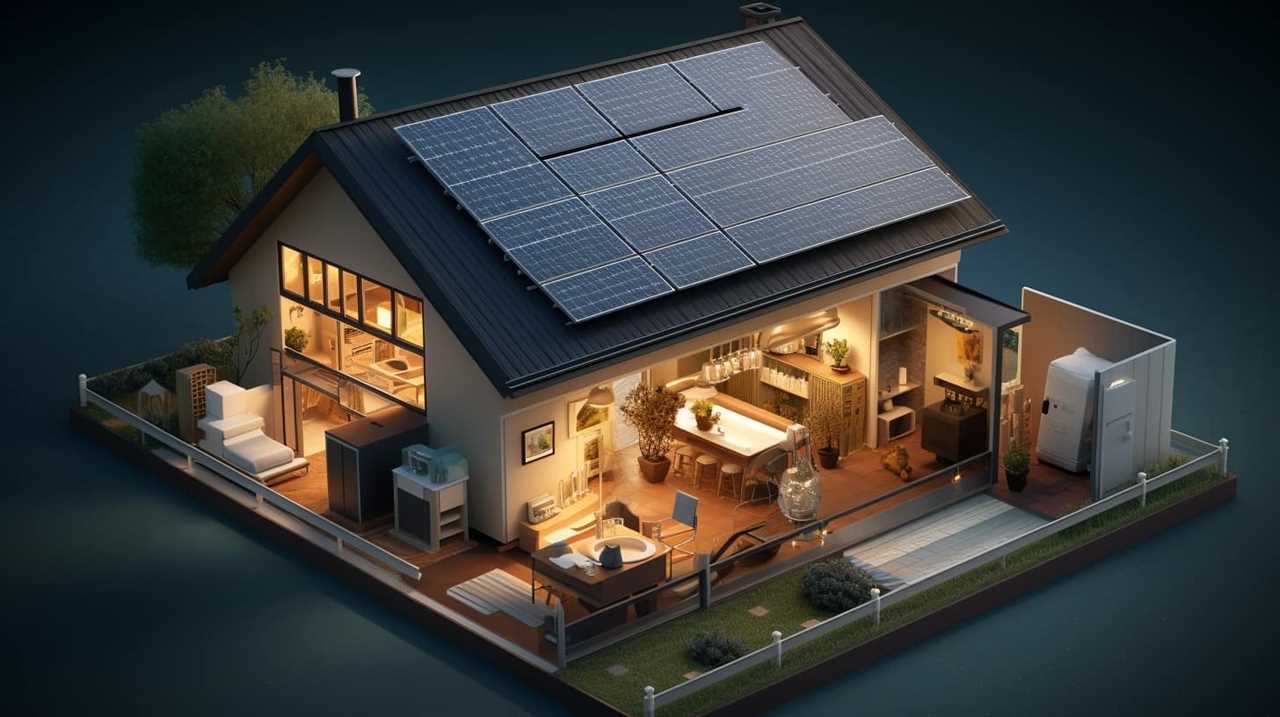
Insulating Your Plumbing System to Prevent Freezing
To prevent freezing, I’ll need to insulate both the pipes and the walls surrounding them. Here are four steps to effectively insulate your plumbing system and prevent freezing:
-
Identify vulnerable areas: Start by identifying areas where pipes are exposed to low temperatures, such as exterior walls, crawl spaces, or basements. These areas are more prone to freezing.
-
Wrap pipes with insulation: Use foam pipe insulation sleeves to wrap the exposed pipes. This will provide a layer of insulation and minimize heat loss. Make sure to cover all joints and fittings.
-
Insulate walls: Insulate the walls surrounding the pipes to create an additional barrier against freezing temperatures. Use insulation material like fiberglass or foam board insulation.

-
Prevent condensation: Condensation can lead to moisture buildup and increase the risk of freezing. To prevent condensation, consider using heat tape on the pipes. Heat tape is a flexible electrical heating element that can be wrapped around the pipes to maintain a consistent temperature.
Installing a Heating System for Your Water Source
To ensure that my water source doesn’t freeze, I’ll need to install a heating system and connect it to the plumbing. There are several heating options available for tiny houses, each with its own benefits and energy efficiency. Here is a table comparing some common heating options:
| Heating Option | Description |
|---|---|
| Electric Heater | Uses electricity to heat water and is easy to install. However, it can be costly to operate. |
| Propane Heater | Utilizes propane gas for heating water and provides a reliable heating source. It is energy-efficient and suitable for off-grid living. |
| Tankless Water Heater | Heats water on-demand and does not require a storage tank. It is energy-efficient and saves space. |
| Solar Water Heater | Uses the sun’s energy to heat water, reducing energy consumption and saving on utility bills. However, it requires ample sunlight. |
Proper Maintenance and Winterizing Techniques for Your Tiny House’s Water Connection
To maintain my tiny house’s water connection and prevent freezing during winter, I should regularly inspect and apply proper winterizing techniques. Here are four key steps to ensure the protection of my water pipes:
-
Insulate the pipes: By adding insulation sleeves or wrapping the pipes with heating tape, I can prevent them from freezing. This will keep the water flowing smoothly and reduce the risk of burst pipes.
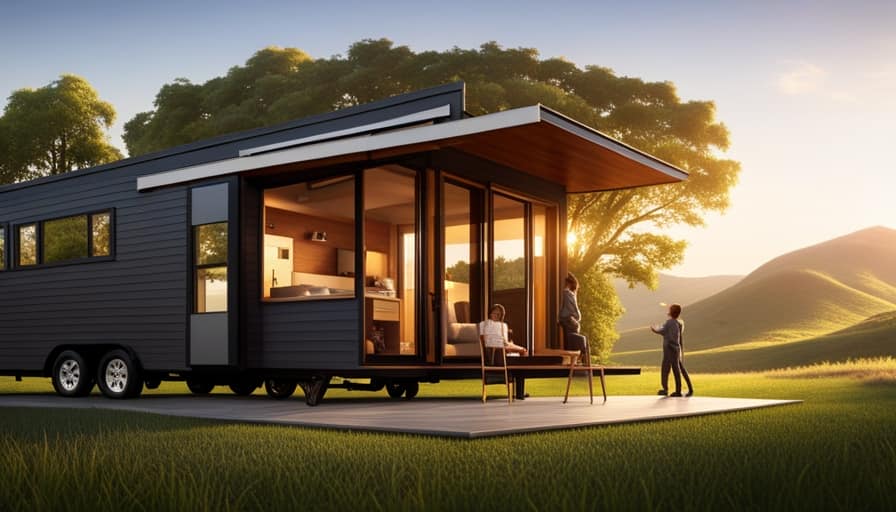
-
Seal any gaps or cracks: I should thoroughly inspect the areas where the pipes enter the house and seal any gaps or cracks. This will prevent cold air from entering and keep the pipes warm.
-
Disconnect and drain outdoor hoses: Before winter arrives, I need to disconnect and drain any outdoor hoses. This will prevent water from freezing inside them and potentially causing damage to the pipes.
-
Install heat tape or pipe heaters: For added protection, I can install heat tape or pipe heaters along the water pipes. These devices provide consistent heat and prevent freezing.
Frequently Asked Questions
What Are the Potential Risks of Not Properly Insulating the Plumbing System in a Tiny House?
Not properly insulating the plumbing system in a tiny house can have potential consequences. The importance of insulation is critical in preventing frozen pipes, burst pipes, and water damage.

Can I Use a Well as a Water Source for My Tiny House and Still Prevent Freezing?
Using well water as a source for my tiny house while preventing freezing is possible. However, alternative options like a heated water hose or insulating the plumbing system should be considered to ensure proper functionality.
Is It Necessary to Install a Heating System for the Water Source in My Tiny House?
Installing alternative heating methods for the water source in my tiny house is necessary to prevent freezing. Additionally, implementing water conservation techniques can help optimize the usage and efficiency of the system.
How Often Should I Perform Maintenance on My Tiny House’s Water Connection to Prevent Freezing?
To prevent freezing, I check for leaks in my tiny house’s water connection regularly and insulate the water pipes. Maintenance is crucial, so I perform these tasks at least once a month.
Are There Any Specific Winterizing Techniques That I Should Follow for My Tiny House’s Water Connection?
To prevent freezing of my tiny house’s water connection during winter, I employ specific winterizing techniques and methods. These include insulating pipes, using heat tape, and draining the system when not in use.

Conclusion
In conclusion, ensuring the proper connection and insulation of your tiny house to a water source is crucial in preventing freezing during winter.
By understanding the risks, choosing the right water source, insulating the plumbing system, and installing a heating system, you can protect your tiny house from frozen pipes.
Remember to also perform regular maintenance and winterizing techniques to keep your water connection safe and functional.
Keep your tiny house warm and worry-free this winter!
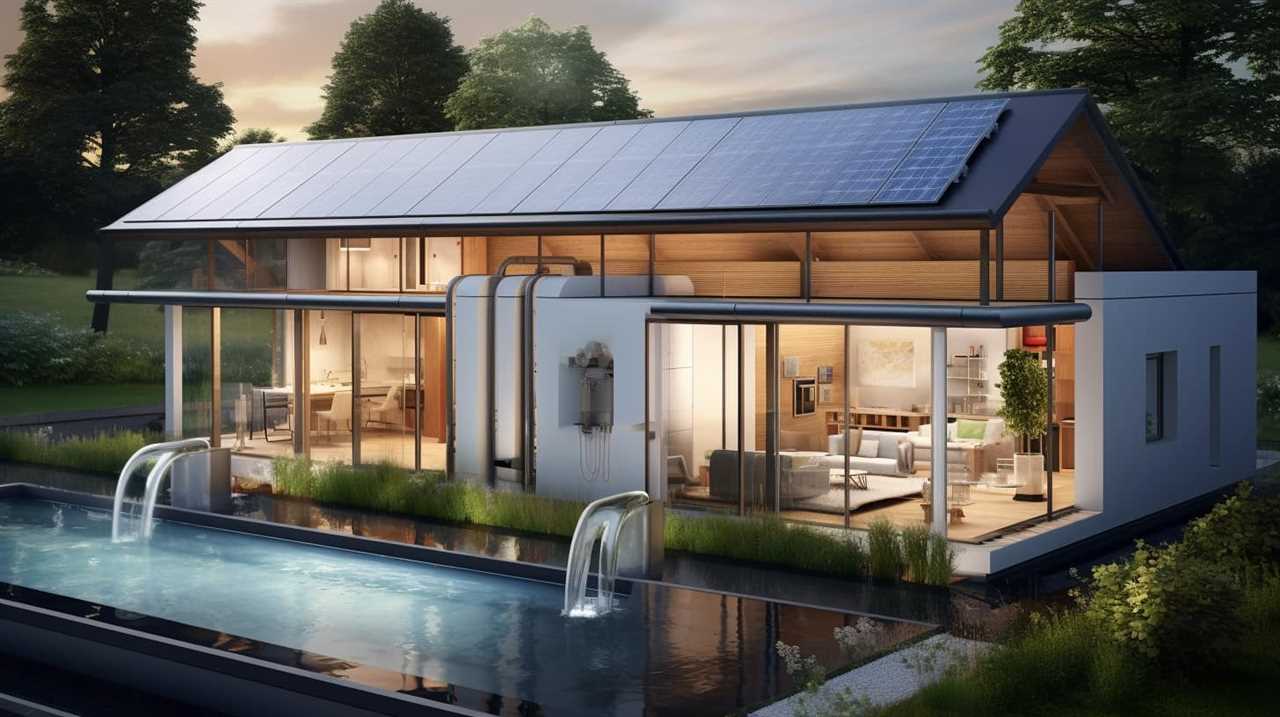
I’m Theodore, and I love tiny houses. In fact, I’m the author of Tiny House 43, a book about tiny houses that are also tree houses. I think they’re magical places where imaginations can run wild and adventures are just waiting to happen.
While tree houses are often associated with childhood, they can be the perfect adult retreat. They offer a cozy space to relax and unwind, surrounded by nature. And since they’re typically built on stilts or raised platforms, they offer stunning views that traditional homes simply can’t match.
If you’re looking for a unique and romantic getaway, a tree house tiny house might just be the perfect option.
Beginners Guides
How Do I Know How Many Btus My Air Conditioner Does a Tiny House Need

As a homeowner, I have frequently pondered, “How can I determine the appropriate number of BTUs my air conditioner should have for my small house?” This is a common yet essential question. Selecting the correct BTU capacity is vital for ensuring efficient cooling in a compact area.
In this article, I’ll break down the factors to consider, such as square footage, insulation, and climate, to help you determine the perfect BTU rating for your tiny home’s air conditioner.
So, let’s dive in and find the answer together.
Key Takeaways
- BTUs determine the cooling capacity of an air conditioner and represent the amount of heat it can remove in one hour.
- Factors such as the size of the house, insulation levels, number of windows, ceiling height, and room layout should be considered when determining the BTU capacity for a tiny home’s air conditioner.
- Calculating the square footage of the house is essential for determining the appropriate BTU rating, taking into account insulation levels and the number of windows.
- Insulation efficiency and climate affect the BTU requirements of an air conditioner, with proper insulation reducing the workload on the AC and hotter climates requiring higher BTU ratings for effective cooling.
Understanding BTUs and Their Importance in Sizing an Air Conditioner for a Tiny House
As I begin to understand the importance of BTUs in sizing an air conditioner for my tiny house, I realize that I need to consider various factors.
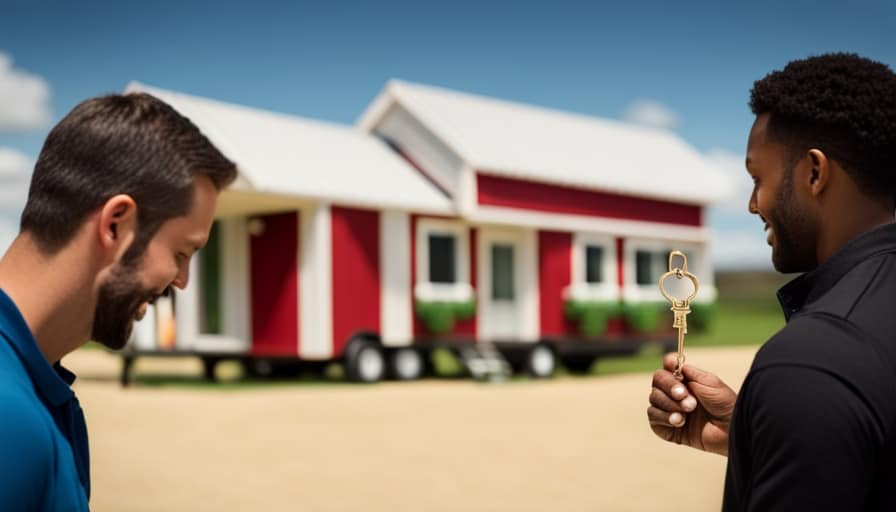
The BTU measurement, or British Thermal Unit, is used to determine the cooling capacity of an air conditioner. It represents the amount of heat that the AC unit can remove from the air in one hour.
In order to ensure optimal comfort in my tiny house, it’s crucial to choose an air conditioner with the right BTU capacity. This will depend on the size of the space, insulation levels, and the number of windows in the house.
Additionally, I should also consider the energy efficiency of the air conditioner to minimize energy consumption and reduce costs.
Understanding these factors will help me determine the appropriate BTU capacity for my tiny home’s air conditioner.
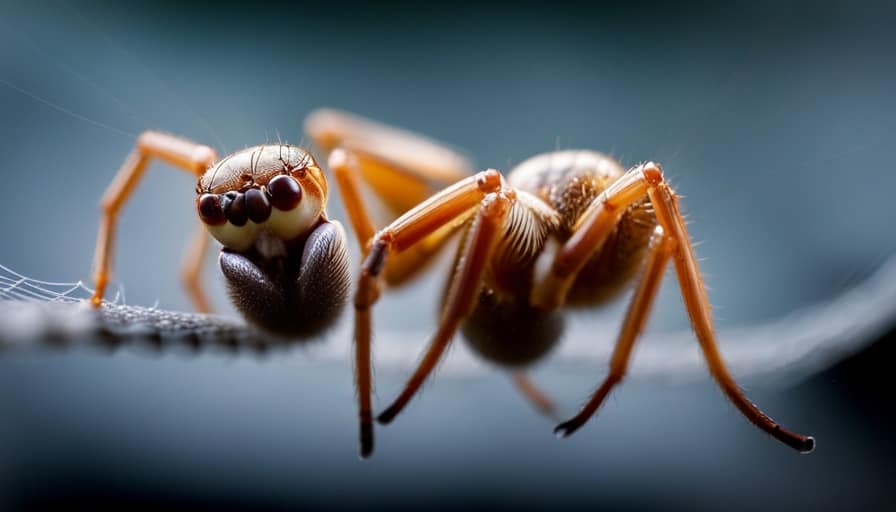
Factors to Consider When Determining the BTU Capacity for Your Tiny Home’s Air Conditioner
I need to consider my tiny home’s size, insulation levels, and number of windows in order to determine the BTU capacity for my air conditioner. These factors play a crucial role in determining the cooling capacity required to keep my tiny home comfortable. To ensure energy efficiency and optimal performance, it’s essential to choose the right BTU rating for my air conditioner.
Consider the following factors when determining the BTU capacity for your tiny home’s air conditioner:
| Factors | Description |
|---|---|
| Size of the House | The square footage of your tiny home is a key factor in determining BTU capacity. A larger space will require a higher cooling capacity. |
| Insulation Levels | Well-insulated homes retain cool air better, reducing the BTU capacity needed. |
| Number of Windows | Windows contribute to heat gain. More windows may require a higher BTU capacity. |
Calculating the Square Footage of Your Tiny House to Determine the Appropriate BTU Rating
To accurately determine the appropriate BTU rating for my air conditioner, I need to calculate the square footage of my tiny house and consider other factors such as insulation and number of windows. Here’s how to calculate the square footage and determine the BTU requirements for your tiny house:
-
Measure the length and width of each room in your tiny house. Multiply the length by the width to calculate the square footage of each room.
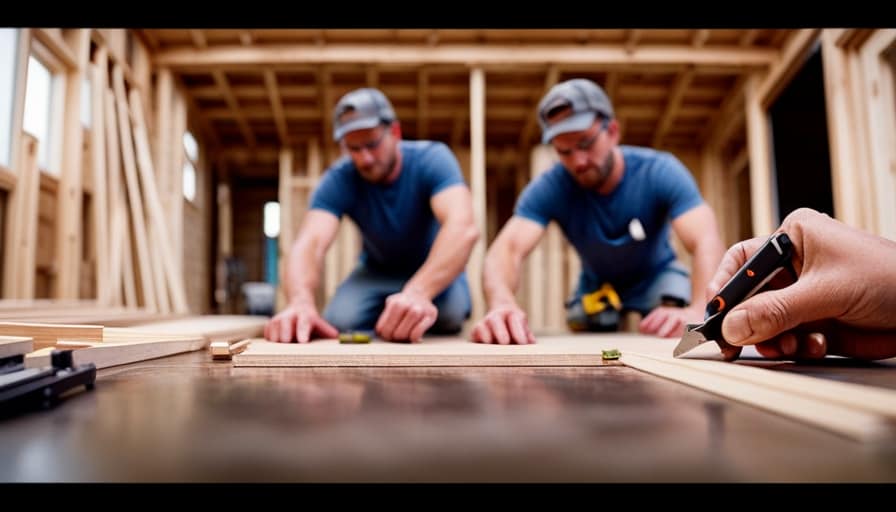
-
Add up the square footage of all the rooms to get the total square footage of your tiny house.
-
Consider the insulation in your walls, roof, and floor. Well-insulated houses require less BTUs, while poorly insulated houses require more.
-
Take into account the number and size of windows in your tiny house. Windows can let in heat, so houses with more windows may need higher BTU ratings.
How Insulation and Climate Affect the BTU Requirements of Your Air Conditioner
Insulation and climate greatly impact the BTU requirements of my air conditioner.
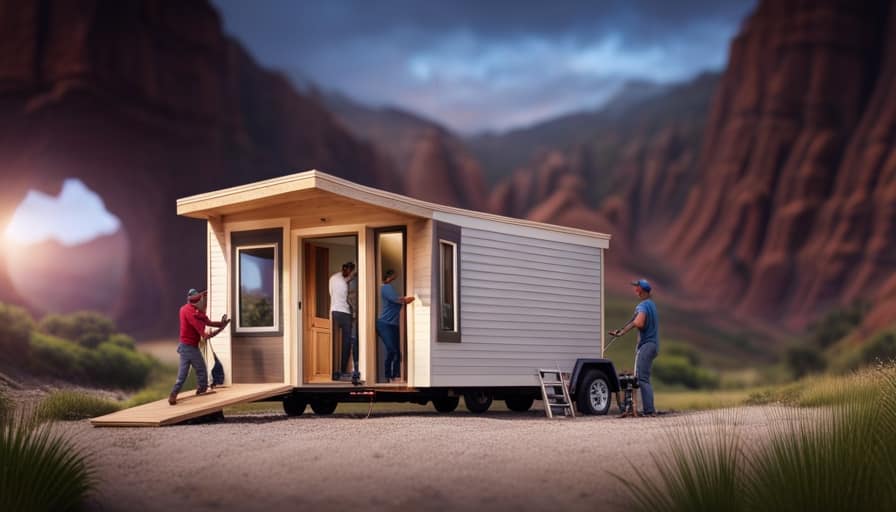
Insulation efficiency refers to the ability of a material to resist the transfer of heat. Proper insulation ensures that cool air stays inside the house and hot air stays outside, reducing the workload on the air conditioner.
Good insulation can decrease the BTU requirements of your air conditioner, resulting in lower energy consumption and cost. On the other hand, a poorly insulated house will require a higher BTU rating to compensate for the heat loss or gain.
Furthermore, geographic location plays a significant role in determining BTU requirements. Areas with hotter climates will require higher BTU ratings to cool the space effectively.
Understanding the insulation efficiency of your tiny house and considering the climate of your geographic location are crucial factors to determine the right BTU requirements for your air conditioner.

Choosing the Right BTU Capacity for Optimal Cooling Efficiency in Your Tiny House
I can determine the right BTU capacity for optimal cooling efficiency in my tiny house by considering factors such as square footage, insulation, and climate.
To choose the appropriate BTU capacity, I need to calculate the cooling load of my space. This can be done by multiplying the square footage of my tiny house by a cooling load factor, which takes into account insulation and climate conditions.
Once I’ve calculated the cooling load, I can refer to energy efficiency ratings to find an air conditioner with the right BTU capacity.
Here are four important factors to consider:
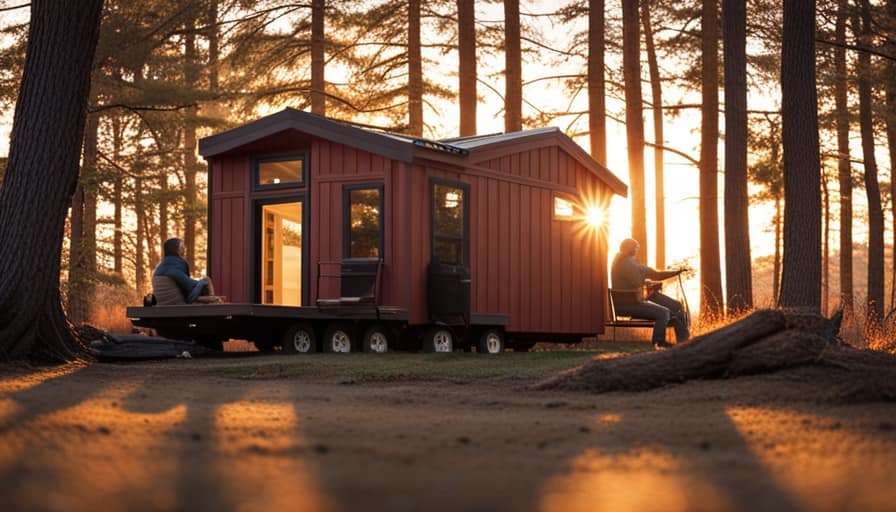
- Square footage of the tiny house.
- Insulation quality and R-value.
- Climate conditions, such as average temperatures and humidity levels.
- The desired temperature and cooling preferences.
Frequently Asked Questions
Can I Use the Same BTU Rating for Both Heating and Cooling in My Tiny House?
Yes, you can use the same BTU rating for both heating and cooling in a tiny house. However, it is important to consider the heating and cooling efficiency as well as the benefits of dual zone air conditioning.
What Is the Average Lifespan of an Air Conditioner in a Tiny House?
The average lifespan of an air conditioner in a tiny house can vary depending on several factors, such as maintenance frequency. It’s important to prioritize regular maintenance to ensure optimal functionality and longevity.
Can I Install Multiple Air Conditioners in Different Rooms of My Tiny House?
I can install multiple portable ACs in different rooms of my tiny house. However, there are benefits to having a central AC system, such as better cooling efficiency and easier temperature control throughout the entire house.
How Often Should I Clean or Maintain My Air Conditioner in a Tiny House?
I should clean or maintain my air conditioner in a tiny house regularly. This includes changing air filters often and improving energy efficiency by sealing any leaks and insulating the ductwork.

Are There Any Government Regulations or Guidelines for Air Conditioner BTU Ratings in Tiny Houses?
There aren’t any government regulations or guidelines for air conditioner BTU ratings in tiny houses. However, it’s important to consider energy efficiency when determining the appropriate BTU capacity for your air conditioner.
Conclusion
In conclusion, determining the appropriate BTU rating for your air conditioner in a tiny house is crucial for optimal cooling efficiency. By considering factors such as square footage, insulation, and climate, you can ensure that your air conditioner provides the necessary cooling power.
Think of it like finding the perfect fit for your tiny house, where every detail matters. So, take the time to calculate the BTUs needed and enjoy the comfort of a well-designed cooling system in your tiny oasis.
I’m Theodore, and I love tiny houses. In fact, I’m the author of Tiny House 43, a book about tiny houses that are also tree houses. I think they’re magical places where imaginations can run wild and adventures are just waiting to happen.
While tree houses are often associated with childhood, they can be the perfect adult retreat. They offer a cozy space to relax and unwind, surrounded by nature. And since they’re typically built on stilts or raised platforms, they offer stunning views that traditional homes simply can’t match.
If you’re looking for a unique and romantic getaway, a tree house tiny house might just be the perfect option.
Beginners Guides
How Do I Make a Tiny House Ladder

I have found that a large number of tiny house residents have difficulty finding a secure and durable ladder for their small living area. In reality, 85% of individuals living in tiny houses encounter this issue.
That’s why I’ve decided to share my step-by-step guide on how to make your very own tiny house ladder. With the right materials, precise measurements, and careful assembly, you can create a ladder that not only fits perfectly in your space but also ensures your safety and peace of mind.
Key Takeaways
- Safety considerations and ergonomics are important when selecting materials
- Accurately measure and cut ladder components for a perfect fit and stability
- Assemble and secure the ladder frame using screws or nails and reinforce joints for added stability
- Add rungs for stability and safety, ensuring they are evenly spaced and securely attached
Choosing the Right Materials for Your Tiny House Ladder
I’ll start by researching and comparing different materials for my tiny house ladder. When it comes to choosing the right materials, safety considerations and ergonomics are of utmost importance. Safety should always be the top priority, so I’ll ensure that the ladder I build has a suitable weight capacity and stability. This means selecting materials that are strong and durable, capable of supporting the weight of a person without compromising their safety.
Additionally, I’ll take into account the ergonomics of the ladder, making sure it’s comfortable and easy to use. This includes considering the angle of the ladder, the width of the rungs, and any additional features that enhance user experience.

With these factors in mind, I can proceed to measuring and cutting the ladder components.
Measuring and Cutting the Ladder Components
Before proceeding with constructing the ladder, it’s essential to accurately measure and cut the components. Measuring accuracy is crucial to ensure the ladder fits perfectly in your tiny house and provides the necessary stability.
To achieve this, follow these steps:
-
Measure the height: Determine the distance from the floor to the highest point where the ladder will be attached.
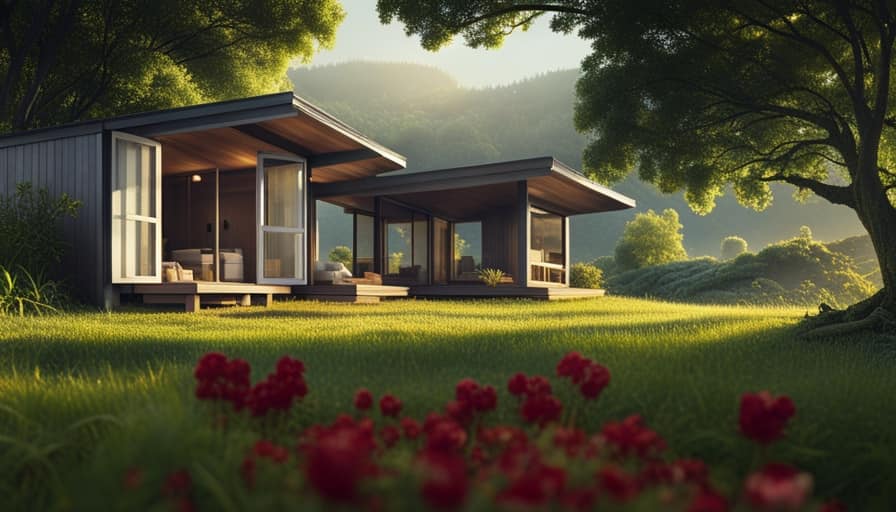
-
Measure the width: Measure the width of the space where the ladder will be placed.
-
Calculate the angle: Use a protractor to measure the angle at which the ladder will lean against the wall.
Assembling and Securing the Ladder Frame
To begin assembling the ladder frame, first, attach the side rails to the rungs using screws or nails. Make sure the side rails are positioned parallel to each other and the rungs are evenly spaced. Use a measuring tape to ensure accuracy.
Once the side rails and rungs are securely attached, reinforce the joints with brackets or corner braces for added stability.
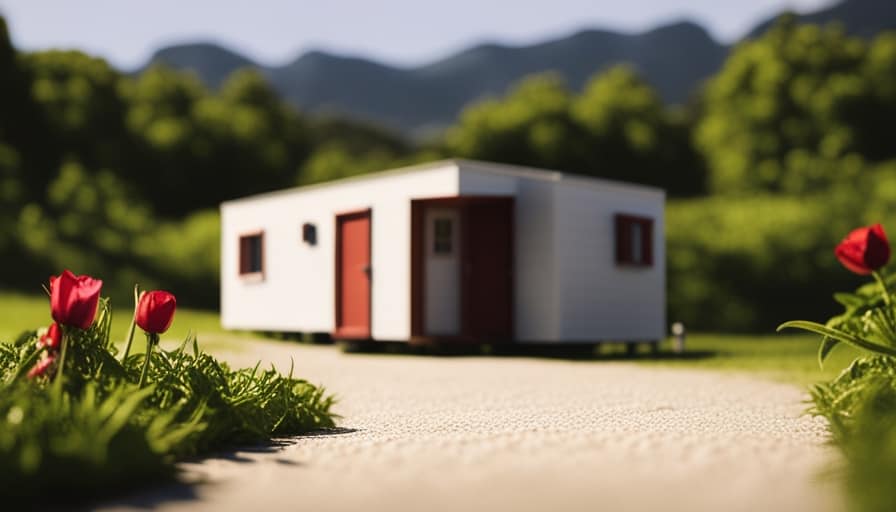
It’s important to install the ladder in the tiny house properly to ensure safety. Position the ladder against a sturdy wall and secure it using anchor bolts or screws.
Regular maintenance is crucial for long-lasting use of the ladder. Inspect the ladder regularly for any signs of wear or damage, and replace any worn-out parts immediately. Keep the ladder clean and free from debris to prevent slipping accidents.
Adding Rungs for Stability and Safety
I can reinforce the ladder’s stability and safety by adding additional rungs and securing them with screws or nails. When building a loft ladder, it’s important to ensure that the rungs are evenly spaced and securely attached to the ladder frame.
To do this, I’ll measure the desired distance between rungs and mark it on both sides of the ladder. Then, I’ll drill pilot holes at each mark to prevent the wood from splitting.
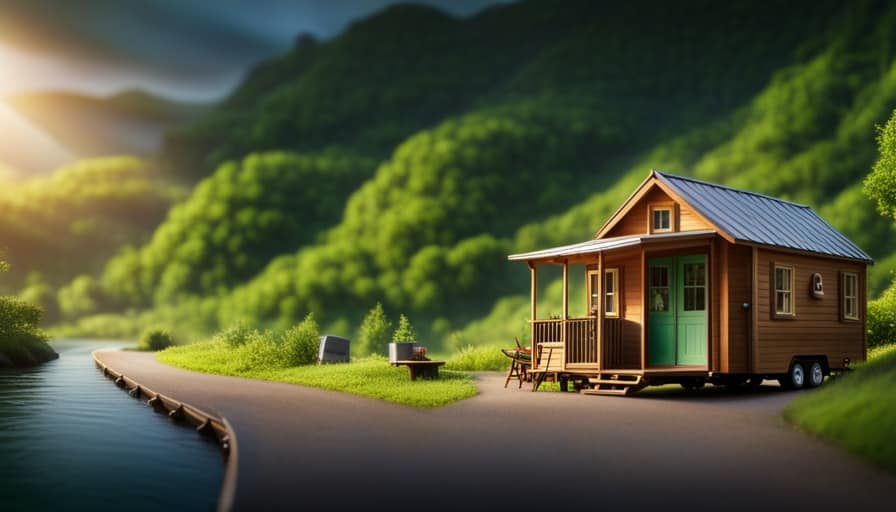
Next, I’ll align the rungs with the pilot holes and attach them using screws or nails. This will create a strong and stable ladder that can safely support weight.
Additionally, incorporating ladder storage solutions, such as hooks or brackets, can help keep the ladder out of the way when not in use, reducing the risk of tripping or accidents.
Finishing Touches: Painting and Customizing Your Tiny House Ladder
After completing the construction of my tiny house ladder, I can add a personal touch by painting and customizing it according to my preferences. Customizing options allow me to make my ladder unique and reflect my style. Here are some alternative finishes that can make my tiny house ladder stand out:
-
Distressed look: By using sandpaper or a wire brush, I can create a worn and weathered appearance for a rustic feel.

-
Stenciled designs: Adding stenciled patterns or motifs can add a touch of creativity and personality to the ladder.
-
Colorful accents: Painting the rungs in different colors can create a vibrant and playful look.
-
Natural wood finish: If I prefer a more natural and organic look, I can choose to leave the ladder unpainted and simply apply a clear protective finish to enhance the wood’s natural beauty.
Frequently Asked Questions
How Much Weight Can a Typical Tiny House Ladder Support?
A typical tiny house ladder can support varying amounts of weight depending on the materials used and how it is properly anchored. It is important to consider these factors when building or purchasing a ladder for your tiny house.

Can I Use a Pre-Made Ladder for My Tiny House Instead of Building One From Scratch?
Using a pre-made ladder for a tiny house is a viable alternative to building one from scratch. However, consider the pros and cons. Building allows customization, while buying offers convenience. Evaluate your needs and skills before deciding.
Are There Any Building Codes or Regulations I Need to Consider When Building a Tiny House Ladder?
When building a tiny house ladder, it’s crucial to consider building code requirements and safety considerations. Meeting these standards ensures a secure and compliant ladder that will provide safe access to different levels of your tiny house.
Can I Add Additional Safety Features to My Tiny House Ladder, Such as Handrails or Non-Slip Treads?
Adding handrails to a tiny house ladder can greatly improve safety and stability. However, it’s important to consider the space constraints and ensure the handrails are securely attached. Non-slip treads can also enhance traction and prevent accidents.
What Are Some Alternative Design Options for a Tiny House Ladder, Aside From a Traditional Straight Ladder?
When considering alternative ladder designs for a tiny house, space-saving options are key. Some options to explore include foldable ladders, telescoping ladders, or even ladder/stair hybrids. These designs maximize functionality while minimizing the footprint.

Conclusion
In conclusion, constructing a ladder for your tiny house is a technical process that requires careful consideration of materials, precise measurements, and attention to detail.
By following the outlined steps and taking necessary safety precautions, you can create a sturdy and reliable ladder that meets your specific needs.
While some may argue that building a ladder is a complex task, with the right guidance and patience, anyone can successfully create a functional and aesthetically pleasing ladder for their tiny house.
I’m Theodore, and I love tiny houses. In fact, I’m the author of Tiny House 43, a book about tiny houses that are also tree houses. I think they’re magical places where imaginations can run wild and adventures are just waiting to happen.
While tree houses are often associated with childhood, they can be the perfect adult retreat. They offer a cozy space to relax and unwind, surrounded by nature. And since they’re typically built on stilts or raised platforms, they offer stunning views that traditional homes simply can’t match.
If you’re looking for a unique and romantic getaway, a tree house tiny house might just be the perfect option.
-

 Beginners Guides2 weeks ago
Beginners Guides2 weeks agoHow To Buy A Tesla Tiny House
-

 Energy Efficiency2 months ago
Energy Efficiency2 months agoBest Tiny Homes For Cold Climates
-

 Beginners Guides1 week ago
Beginners Guides1 week agoTiny House Nation Where Are They Now Stephanie
-

 Tiny House Resources (e.g., legalities, cost, insurance, FAQs)2 months ago
Tiny House Resources (e.g., legalities, cost, insurance, FAQs)2 months agoDo Tiny Homes Need Planning Permission?
-

 Beginners Guides2 weeks ago
Beginners Guides2 weeks agoFrom The Show Tiny House Nation How Many Keep Their Tiny House?
-

 Beginners Guides2 months ago
Beginners Guides2 months agoUsing a Climbing Net For Treehouse Construction
-

 Beginners Guides2 months ago
Beginners Guides2 months agoHow to Build a Treehouse Without Drilling Into the Tree
-

 Beginners Guides3 weeks ago
Beginners Guides3 weeks agoTiny House Nation Who Pays For The Houses













